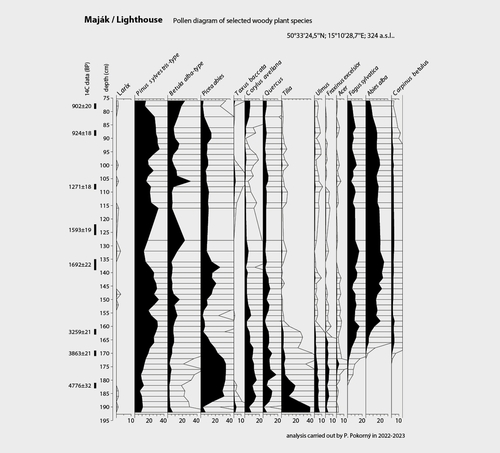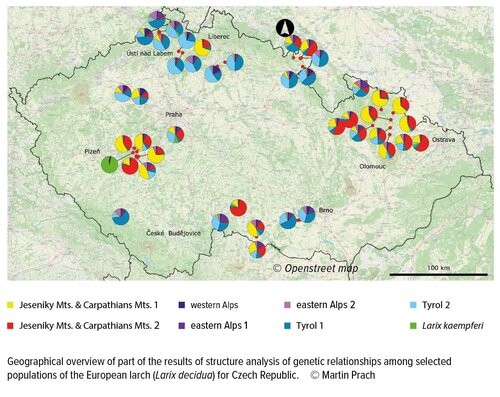Nature Conservation 2025 — 31. 7. 2025 — Research, Surveys and Data Management — Print article in pdf
The European Larch More Native than Previously Thought. How to manage it in Specially Protected Area
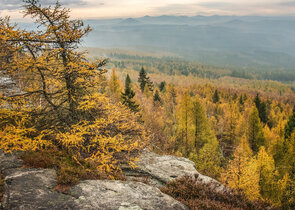
The idea that the European larch (Larix decidua) is native only to the Nízký Jeseník/Low Jeseník Mts. (northern Moravia and southern Silesia) between the Alps and the Carpathians is being changed by new research documenting larch surviving for thousands of years at some sites in the North Bohemian sandstones. We do not have such detailed research elsewhere, so we do not know if larch grew there for a long time. Nevertheless, shifts and uncertainties in knowledge need to be taken into account in conservation planning. It does not make sense to eliminate larch across the board from common regularly managed commercial forests and within protected areas. On the other hand, in rocky habitats and areas less affected by forestry, it should be protected as a potentially interesting and valuable relic for nature conservation. The case of the European larch shows how scientific knowledge is progressing and how the interests of nature conservation and production forestry can be reconciled.
Native and non-native species are not like black and white
The nature conservation approach to species considered non-native is not uncomplicated. Some species are native to other continents. Some cause obvious damage. The need to eradicate such species in nature conservation areas can hardly be disputed. Other species are native to nearby parts of Europe and have only previously been limited by dispersal possibilities, climate, competition from other species, etc. Such species may not have occurred in the Czech Republic in the recent past, but their distribution may be changing in the same way as the drivers determining their distribution, e.g. the climate mentioned above. The conservation approach to such non-native species is different - nobody is trying to eradicate the False Oat-grass (Arrhenatherum elatius) from common meadows, or the Meadow brome (Bromus erectus) from steppe grasslands. Neither is the Eurasian collared dove (Streptopelia decaocto) from the Czech Republic’s avifauna.
The view on the issue of (in)originality in the light of the constant passage of time and long-term changes in nature is essential, although difficult to grasp for everyday nature conservation practice. Words such as ‘native’, ‘natural’ or ‘natural’ (state, habitat, species occurrence, forest composition, etc.) are commonly included in many protected area management plans and various conservation documents without explicitly considering what state we are referring to. To a past one? (But how old?) Or to a hypothetical state without humans? (But in today’s climate, or perhaps in another climate of a time before significant human influence?) Moreover, scientific knowledge is deepening and interpretations are becoming more precise. Larch is a good example of shifts in knowledge and the resulting necessary changes in nature conservation practice. As we will show below, the lack of tangible evidence of the larch’s long-term survival used to be overestimated and gradually resulted in “textbook truths” about the non-nativity of the European larch in the Czech Republic everywhere outside the Nízký Jeseník/Low Jeseník Mts. area.
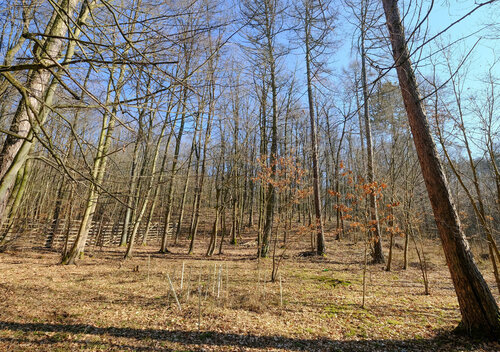
Larch trees can maintain gaps and clearings in otherwise shady deciduous broad-leaved forests after traditional management is abandoned. A site with the critically endangered Ladybells (Adenophora liliifolia) in former oak-hickory coppice forest in the Karlštejn National Nature Reserve. © Jindřich Prach
Windows into the past - paleoecology and molecular phylogeography
We do not have a time machine to look at what ecosystems looked like in the past. We can only make indirect estimations through various scientific methods and with varying degrees of imprecision. Paleoecology examines the remains of organisms in old strata. In the Czech Republic’s conditions, these are most often peat, sediments in pools, lakes or fishponds, or sediments of rocks under overhangs of rocks and in caves. In the layers, plant remains - pollen, seeds, charcoal, etc. - and animal remains - vertebrate bones, mollusc shells, insect fragments - can be identified in various ways. The problem with larch is that it produces less pollen than other common woody plant species. Its pollen is harder to disseminate, poorly preserved and difficult to identify and determine. The microstructure of larch wood very resembles that of the Norway spruce (Picea abies); when identifying e.g. carbon from archaeological surveys or timber from building structures, the mixed item spruce/larch is usually reported. Therefore, larch difficult to detect by routine methods.
Research into the relatedness and diversity of current populations provides a different perspective on the past. From analysing DNA fragments from multiple individuals and multiple sites, we can compare how individuals differ in their heritable traits and which sites resemble more the other (for a discussion of the method, cf. Fér et al. 2021). From this we can estimate with some probability how species have spread across Europe in the past. In the case of the European larch e.g. which populations are closer to the Carpathian ones, which to the Alpine ones, which are probably pure plantings from a single distant source, and which, on the other hand, are a heterogenous mixture. At some sites, the genetically admixed Japanese larch or karamatsu (Larix kaempferi) has been found without this being obvious at first glance.
Simplified pollen diagram from a peat borehole at the Maják/Lighthouse site in the Český ráj/Bohemian Paradise. © Petr Pokorný
Geographical overview of part of the results of structure analysis of genetic relationships among selected populations of the European larch (Larix decidua) for Czech Republic. © Martin Prach
Changes during the Ice Age and post-ice age
When considering the formation of today’s habitats, it is useful to start with the last ice age, tens of thousands of years ago. Let us not imagine the Last Glacial Period (LGP) as in popular movies. Central Europe was quite warm in summer, with glaciers as far away as somewhere beyond present-day Berlin. But there were droughts and cold winters there. This suited the deciduous larch and the tree species was probably widespread in the present-day Czech Republic’s territory (cf. i.a. Jankovská & Pokorný 2015, Pokorný & Abraham 2021). To what extent these were single trees in more favourable conditions e.g. near rivers, or more continuous larch boreal forest/taiga is unclear - both are possible (Prach et al. 2023). In any case, the presence of larch in the last Ice Age is evidenced from multiple sites from pollen finds and also from cone and wood finds (e.g. from the present-day Prague-Podbaba site from analyses of 30,000 – 40,000-year-old deposits of a former river branch/arm discovered during foundation excavation; Jankovská & Pokorný 2008). Larch coal has also been found in mammoth hunters’ fire rings e.g. from the resent-day Brno area. The situation can be summarized as saying that where the respective old layers were well preserved and studied in detail, larch was usually found.
However, knowledge about the occurrence of larch under ice age conditions will not help us much in today’s practice. There was a substantial change after the Ice Age, when other woody plant species gradually became dominant as the climate had become wetter. First pine (Pinus spp.) and birch (Betula spp.), then oak (Quercus spp.) and more demanding species (hazel Corylus spp., lime Tillia spp., maples Acer spp.) and spruce. Later, beech (Fagus spp.) and fir (Abies spp.), which was already under the strong influence of prehistoric farmers. Later still, and at lower altitudes, hornbeam (Carpinus spp.) came to dominate. Larch gradually retreated. As a heliophilous, shade-intolerant species, it clearly was not able to successfully compete with shady forests (Dudová & Szabó 2022). However, it apparently did not disappear everywhere, as we will show below.
Larch in the last centuries
There are no reliable reports on larch from the Middle Ages and the early modern period (more Nožička 1962). The situation is even more obscured by the unclear nomenclature of the woody plants. Larch was often called ‘cornel or dogwod’, in some regions even ‘yew’ (cf. Meduna & Prach 2021). The fact that larch was not commonly found in Bohemia, at least not as structurally useful timber, is suggested by a reference in Mattioli’s herbarium (16th century), which reminds us that larch wood for gutters in Prague was bought and imported from the Bruntál region located in the Nízký Jeseník/Low Jeseník Mts. on the Moravian-Silesian border. Since at least the end of the 17th century, larch has been commonly cultivated for forestry.
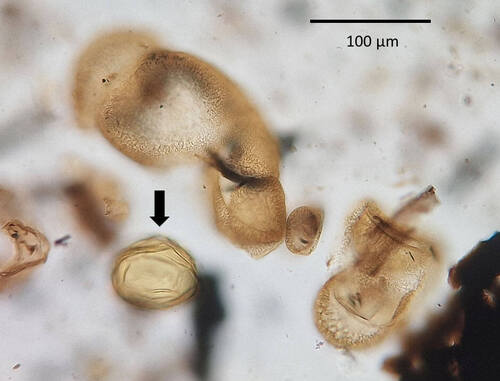
Pollen grain of larch (marked with an arrow) together with pollen of fir and pine identified in layers dating back to the Bronze Age in the České Švýcarsko/Bohemian Switzerland. © Petr Pokorný
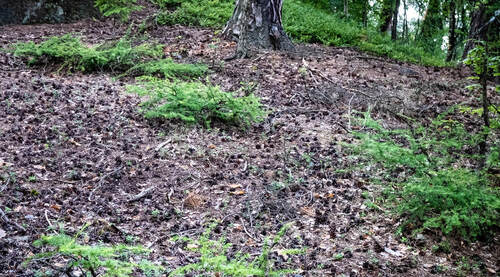
Dwarf, probably browsed or bitten by game forms of larch in the Český ráj/Bohemian Paradise. © Jindřich Prach
New findings - larch documented in North Bohemian sandstones
Paleoecological research requires suitable sediments. Peat-bogs and other wetlands are very rarely located in dry rock pine habitats where heliophilous larch is more expected to be found. Therefore, the species has almost escaped from palynological research for a hundred years. Individual pollen grains used to be considered as accidental long-distance transfer by wind, misidentification or contamination by current pollen. It is only in recent years that sediments have been found in the immediate vicinity of rock edges. The sites and findings from these have been described elsewhere (cf. Pokorny et al. 2023 - in the freely available Forest Research Reports). In this article, we will present only a brief summary. In the Český ráj/Bohemian Paradise, in the Hruboskalsko Nature Reserve, a peat deposit was discovered at the Maják site, accumulated over the last 5,500 years or so. Larch pollen is present in small quantities, but has been repeatedly documented in about ten differently aged layers. In another part of the Český ráj/Bohemian Paradise, in the Příhrazské skály Nature Reserve, layers of domestic animal dung stabled in the rock overhang during the Iron Age have been studied (Ptáková et al. 2021). These contain plant opals, so-called phytoliths, very probably originating from larch needles. Other findings come from similar conditions in the rocks of the Labské pískovce/Elbe Sandstone and České Švýcarsko/Bohemian Switzerland. In a fissure cave on the edge of the Labe/Elbe River canyon, right in the present-day relict rock pine stands, the sediment formed on its difficult-to-access bottom was studied by D. Vondrák et al. Larch pollen occurs in layers dating back 6,700 years and older, i.e. from a period dominated by deciduous broad-leaved forests, when it was assumed that larch had already been displaced from forests in the Czech Republic by these competitively stronger tree species. Another nearby site, the Okrový převis/Ochre Overhang at Pravčický důl, where detailed research has still been in progress, has shown larch pollen grains in Bronze Age layers.
Molecular phylogeographic analyses carried out so far on 559 individuals within 44 sites in the Czech Republic have not yet revealed any possible “Czech lineage” significantly different from the Alpine or Carpathian ones. It appears, however, that at most Czech sites, including rock edges in the vicinity of paleoecologically studied sites, alpine-related larches predominantly grow. The fact that these are plantations rather than the natural alpine range extending into Bohemia is suggested by the finding that larches are mostly close to Tyrolean populations, from where seed was historically traded, rather than to populations in the eastern Alps, where it would be closer in the case of natural dispersal. This somewhat corrects the conventional wisdom in forestry community that the Alpine larch was not initially successful in cultivation because it suffered from ‘canker’, and thus, it was subsequently replaced by the predominantly Jeseník larch. On the contrary, the larch populations from the Brdy Highlands (Central Bohemia) are closer to the Jeseníky and Carpathian larches. However, it has still been too early to assess whether the Brdy larch is a relatively pure plantation originating from the Jeseníky Mountains for historical reasons, or whether some “Czech” larch, genetically close to the Jeseníky and Carpathian larches, has hypothetically survived there. Several other sites seem to be equally “suspicious”. Molecular phylogeography has also revealed alpine plantations in some small-size Specially Protected Areas in the Nízký Jeseník/Low Jeseník Mts., where the native Jeseník larch is directly under protection (Prach et al. 2023). How to approach larch in conservation practice?
Larch has apparently not spread widely across Central European ecosystems in recent millennia, even though it grew nearby and would have had somewhere to come from. So we need not fear its massive spread at the expense of natural habitats. Its occurrences in economic forests, even if they are in protected areas (e.g. in the third or even second zones of protected areas, in MZCHÚ with a different object of protection than the forest ecosystem), do not have to be considered a risk either. There is no reason to eliminate larch. In forests where larch has been cultivated for centuries, there is no reason why this should not continue to be the case. We are not considering larch-dominated stands in which larch does not thrive and which are only occasionally left over from earlier times. In practice, it is a mixture of larch, which can be a structural enrichment in spruce, for example, but also in beech and oak woodland. From a conservation point of view, the presence of larch is often indifferent, yet from a forestry point of view larch can be an important carrier of production and economic value.
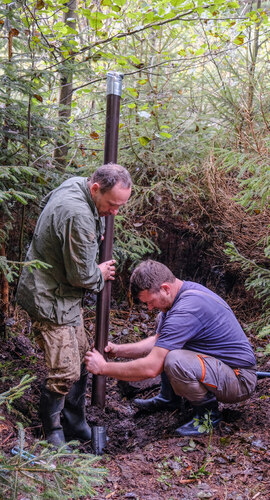
Borehole sediment sampling at the Maják/Lighthouse site in the Český ráj/Bohemian Paradise. © Jindřich Prach
How to approach larch in conservation practice?
Larch has apparently not spread widely across Central European ecosystems in recent millennia, even though it grew nearby and would have had somewhere to come from. Therefore, there is no fear on its massive spread at the expense of natural habitats. Its occurrences in commercial forests, even if they are in Specially Protected Areas (e.g. in the third or even second zones of Protected Landscape Areas, in small-size Specially Protected Areas with a different object of protection/conservation/management than the forest ecosystem), do not have to be considered a risk either. There is no reason to eradicate larch there. In forests where larch has been cultivated for centuries, there is no reason why this should not continue to be the case. We are not considering larch-dominated stands in which larch does not thrive and which are only occasionally left over from earlier times. In practice, it is a mixture of larch, which can be a structural enrichment in spruce, for example, but also in beech and oak/hornbeam woodland. From a conservation point of view, the presence of larch is often indifferent, yet from a forestry point of view larch can be an important for production and economic value.
More important from the point of view of nature conservation, however, may be the potential surviving relict larch populations that may be hiding in many Specially Protected Areas without our knowledge. Such populations could be everywhere in the Czech Republic outside the Nízký Jesník/Low Jeseník Mts. region, where this was not in doubt. Moroever, clearly relict populations have not yet been confirmed elsewhere in the Czech Republic. It will always be methodologically difficult. Genetic analyses always provide results only with some degree of probability or uncertainty. Paleoecological methods, even if they reveal the presence of larch in prehistoric and medieval times, cannot tell us whether the larches there are their direct descendants or recent plantings from elsewhere. If there are relict occurrences of larch anywhere, they will probably already have been genetically diluted by plantings from the surrounding area. Nevertheless, the possibility of potential survival of larch in the Czech Republic should be kept in mind in nature conservation planning and local interventions.
Potentially interesting populations can be identified by various indications. Historical records are scarce, and there is no choice but to estimate from natural conditions. These are places where long-term reduced competition from other woody species can be expected, e.g. on cliff edges, in scree or generally in rock pine forest habitats. In general, sites where there are other heliophilous relict species, e.g. plants or some poorly dispersing insects, may be promising for larch. The forester and nature conservationist should also be alert when they find larch in areas that are difficult to access by logging and in old stands where planting has probably not taken place for as far back memory goes.
In the light of the new findings from the North Bohemian sandstones, it is necessary to reconsider the previous conservation approach to the European larch and pay attention to such potentially relict surviving populations throughout the Czech Republic. At the very least, the eradication of larch from Specially Protected Areas should not be proposed across the board. Equally important is not to replant larch or promote its spreading from earlier plantings. Planting of genetically different individuals would dilute a potentially valuable local population.
In summary, larch and its reasonable economic cultivation as an admixture in forests across the Czech Republic does not seem to be a threat to nature conservation. Further research would even discover populations displaying high nature conservation values. The admixture of larch in commercial forests can be a good trade-off between commercial-economic and nature conservation interests, in conservation planning and negotiations both on the local and national level. Thus, in nature conservation planning and negotiation, whether local or national, let us not waste for the sake of larch the energy and capacity so necessary to suppress tree species from other continents, such as the Northern red oak (Quercus rubra) or the Douglas fir (Pseudotsuga menziesii).
The text was written with the support of the National Agency for Agricultural Research project NAZV QK21010335 Possibilities of using larch in Czech forests under the impact of global climate change (LARIXUTOR) and with the support of the Technology Agency of the Czech Republic project within the programme Environment for Life No. SS07010074 Paleoecological reconstruction of ecosystems as a basis for planning the conservation of Specially Protected Areas. ■
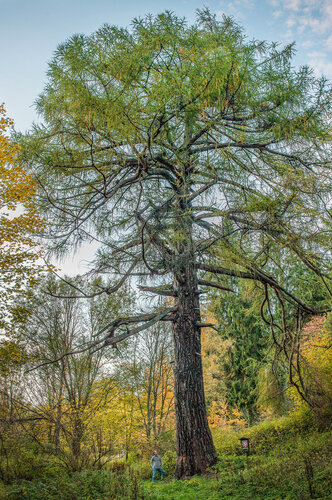
Larch can grow to a considerable size under favourable conditions. The biggest larch in the Czech Republic grows near the municipality of Benešov nad Cernou in the Novohradské hory Mts. (South Bohemia).
© Jindřich Prach
- - - -
Cover photo: Under some rock edges of the North Bohemian sandstones, it has been newly discovered that the European larch survived there, at least in small quantities, together with pine trees for thousands of years. © Jindřich Prach
- - - -
The list of references is attached to the online version of the article at www.casopis.ochranaprirody.cz


